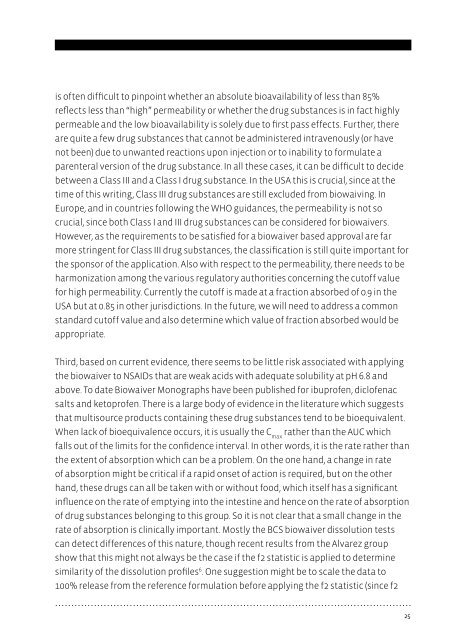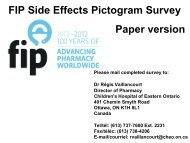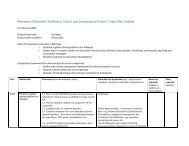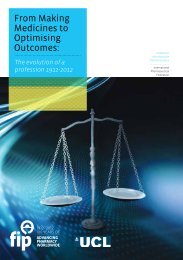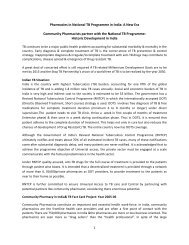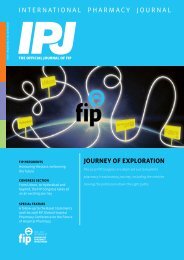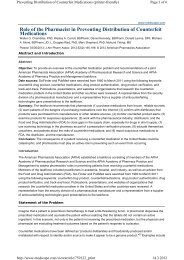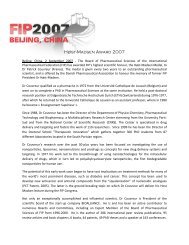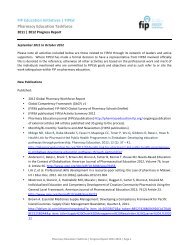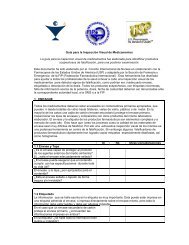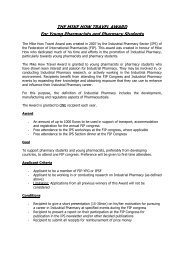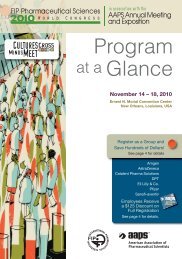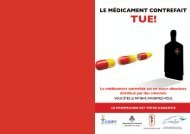THe BIOWaIVer MONOGraPHS - FIP
THe BIOWaIVer MONOGraPHS - FIP
THe BIOWaIVer MONOGraPHS - FIP
Create successful ePaper yourself
Turn your PDF publications into a flip-book with our unique Google optimized e-Paper software.
is often difficult to pinpoint whether an absolute bioavailability of less than 85%<br />
reflects less than “high” permeability or whether the drug substances is in fact highly<br />
permeable and the low bioavailability is solely due to first pass effects. Further, there<br />
are quite a few drug substances that cannot be administered intravenously (or have<br />
not been) due to unwanted reactions upon injection or to inability to formulate a<br />
parenteral version of the drug substance. In all these cases, it can be difficult to decide<br />
between a Class III and a Class I drug substance. In the USA this is crucial, since at the<br />
time of this writing, Class III drug substances are still excluded from biowaiving. In<br />
Europe, and in countries following the WHO guidances, the permeability is not so<br />
crucial, since both Class I and III drug substances can be considered for biowaivers.<br />
However, as the requirements to be satisfied for a biowaiver based approval are far<br />
more stringent for Class III drug substances, the classification is still quite important for<br />
the sponsor of the application. Also with respect to the permeability, there needs to be<br />
harmonization among the various regulatory authorities concerning the cutoff value<br />
for high permeability. Currently the cutoff is made at a fraction absorbed of 0.9 in the<br />
USA but at 0.85 in other jurisdictions. In the future, we will need to address a common<br />
standard cutoff value and also determine which value of fraction absorbed would be<br />
appropriate.<br />
Third, based on current evidence, there seems to be little risk associated with applying<br />
the biowaiver to NSAIDs that are weak acids with adequate solubility at pH 6.8 and<br />
above. To date Biowaiver Monographs have been published for ibuprofen, diclofenac<br />
salts and ketoprofen. There is a large body of evidence in the literature which suggests<br />
that multisource products containing these drug substances tend to be bioequivalent.<br />
When lack of bioequivalence occurs, it is usually the C max rather than the AUC which<br />
falls out of the limits for the confidence interval. In other words, it is the rate rather than<br />
the extent of absorption which can be a problem. On the one hand, a change in rate<br />
of absorption might be critical if a rapid onset of action is required, but on the other<br />
hand, these drugs can all be taken with or without food, which itself has a significant<br />
influence on the rate of emptying into the intestine and hence on the rate of absorption<br />
of drug substances belonging to this group. So it is not clear that a small change in the<br />
rate of absorption is clinically important. Mostly the BCS biowaiver dissolution tests<br />
can detect differences of this nature, though recent results from the Alvarez group<br />
show that this might not always be the case if the f2 statistic is applied to determine<br />
similarity of the dissolution profiles 6 . One suggestion might be to scale the data to<br />
100% release from the reference formulation before applying the f2 statistic (since f2<br />
25


